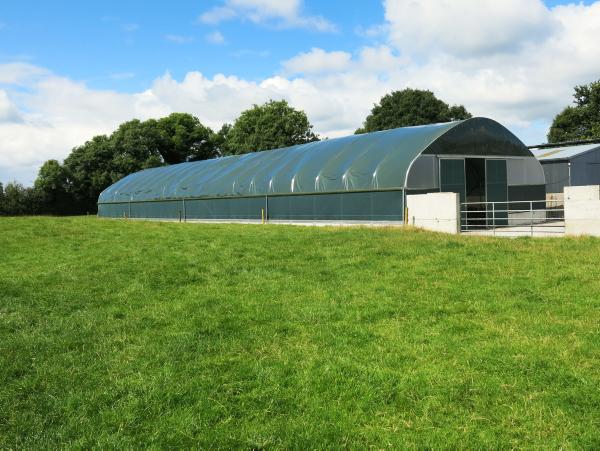This week, I feature a polytunnel, which is a low-cost alternative to a steel shed. It’s also quicker to put up. This one is in the yard of sheep farmer Gordon Johnson of Tyrrellspass, Co Westmeath, and it was put up in late 2012, at the end of a very wet year.
Gordon told me that the normal routine was to graze March-lambing ewes outside until mid-January. In 2012, he had the grass on hand, but despite this land being high and dry, ground was going to be too wet to use. So he took the decision to put up a tunnel. The job started in early November and ewes were inside just three weeks later.
The tunnel was supplied and erected by Colm Warren. Gordon organised concrete work himself with local help. Gordon can now put ewes in the tunnel when weather or ground deteriorates and then move them across to the lambing shed.
Picture one
The tunnel is 120ft long and 36ft wide. The length is the equivalent of eight hayshed bays. It’s sited on the edge of Gordon’s yard and blends in very well.
Gordon had the option of a white polythene cover, which would not stretch or contract as temperatures change. However, he opted for this double-skin green cover as it’s more suited to a farmyard setting.
Picture two
A tunnel can be erected on a bare green field. After discussions with Colm Warren, Gordon decided to sit it on a 2ft-high, 9in-wide shuttered wall and to pour a 4in concrete floor. The wall lifts the tunnel 2ft off the ground – we can see the roof is high.
This also levelled off the site as we can see the ground at the back of the tunnel is rising.
Picture three
In this picture, we can see the benefits of the wall. There is plenty of clearance under his roof structure for cleaning out and for ventilation. Gordon divided the shed area into an 11ft centre passage with 12ft-wide pens on either side.
The concrete floor makes cleaning out with the loader straightforward. “I have to be careful at the sides with the mirrors,” said Gordon.
There’s a sliding door at the front end only, so everything is pushed out through it. Gate posts are sleeved in the floor and everything lifts out for cleaning.
We can see that the roof structure has pillars/rafters made of aluminium tube, with bracing tubes at the top and sides, all tucked well up into the roof area.
Five long support bars run the length of the roof – three in the middle, and one at eave height on either side – much like purlins in a steel shed. Outside, there is a gutter on each side for rainwater.
The tunnel is bright, which makes it pleasant to work in. The side walls are a 5ft-high strip of open plastic mesh which lets in light and air.
The roof material itself lets in a little light, which also helps. Gordon opted for similar mesh at each gable end and this adds a lot to brightness.
Picture four
Gordon had six of these fluorescent lights fitted on each side. “I’ll never have the same chance again to do it.”
Picture five (six inset)
The shuttered wall is able to withstand the pressure of dung building up, Gordon noted.
“You can see the line on the walls that the dirty straw rises up to.” At cleaning time, the wall is there to be pushed against.
At each end, support bars run from the wall up to the rooftop at a 45° angle. The roof cover is under tension, which must be resisted by the roof metal.
The roof pillars end in a bottom plate, which sits on top of the side wall (inset). It is bolted into the outside face of the wall.
Gordon has run an electric strand at the footplate to discourage ewes from chewing at the roof fabric.
Picture seven
The shed is airy and here’s the reason why. “At the same time, the material is just 20% open so it does not let rain in,” Gordon said.
Cost
This tunnel cost €13,000 plus VAT erected (excluding floor and wall). This works out at €3 per sq ft. A simple steel shed would cost €5 to €6.
The tunnel roof skin has a seven-year guarantee and a replacement sheet today is priced at €1,500 fitted. The aluminium framework can be expected to last a long time.
A tunnel can be erected in one week on a prepared concrete or other base. Lower-priced tunnels are available, but might not have the same standard of finish.






 This is a subscriber-only article
This is a subscriber-only article
















SHARING OPTIONS: